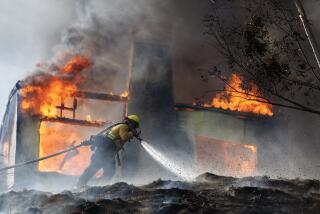Bills Challenge Limits on Air Tanker Use in Fires : Firefighting: The measures, including one by Rep. Gallegly, would enable Air National Guard planes to be immediately available to battle blazes.
Nine months after federal red tape grounded two Air National Guard tankers during a rash of wildfires, two bills that would free them from such strictures are awaiting action in Congress.
The bills, authored by Reps. Elton Gallegly (R-Simi Valley) and David Dreier (R-Covina), seek to free the Guard’s giant C-130 Hercules military transport planes to respond immediately to fires.
Currently, the eight C-130s equipped for firefighting can be called out only after federal officials have exhausted a list of 40 private operators of air tankers--a requirement of a 1932 act aimed at preventing the military from competing with private enterprise.
Two of those eight aircraft are based at the Channel Islands 146th Tactical Airlift base near Point Mugu.
Both bills would exempt firefighting efforts from the 1932 act and would also direct the U. S. Forest Service--which coordinates the tankers while fighting major brush fires--to consider establishing an early warning system. Such a system would allow the Guard to begin mobilizing against brush fires whenever hot desert winds--known as Santa Anas--blow.
“It is critical for us to make these changes now, before we again find ourselves operating in crisis, hamstrung by flawed resources and bureaucratic inefficiency,” Gallegly said.
*
Likewise, Dreier, who represents portions of the San Gabriel Valley near last year’s Altadena blaze, said the Guard’s tankers must be made to respond faster when firestorms get out of hand.
But according to federal wildfire managers, the existing system works. They said the bills would redefine the role of the Guard in wildfires and could damage military readiness to transport troops and equipment--tasks considered the Guard’s main job.
“This is just public relations firefighting,” said Woody Williams, national fire mobilization officer at the National Interagency Fire Center in Boise, Ida. “The simple truth is that the Guard’s tankers are not designed to be initial attack aircraft and they’re not all that effective in high-wind situations.”
Williams said the government’s fleet of 40 contracted private air tankers have more modern and more efficient fire retardant distribution systems than the Guard’s planes, and that those systems operate better in high winds.
Bob Will, an air service manager for the U. S. Forest Service in Hemet, said the delay in getting the C-130s in the air last fall has been overblown.
“We look at the Guard as our ace in the hole,” Will said. “The truth is that during typical fire seasons they will be used two or three times a year--obviously more during situations like last year.”
But the two tankers based at Point Mugu, along with two Air Force Reserve C-130s based in Colorado, flew more than 40 missions last week alone battling forest fires in Idaho--dumping more than 110,000 gallons of chemical fire retardant, base officials said Friday.
*
Col. John Iffland, the Air National Guard’s commanding officer at Point Mugu, said he would support changing his unit’s mission to respond faster to wildfires.
“We are certainly supportive of the legislation,” Iffland said. “In an emergency, you have to fill the breach as soon as you can with all of your resources.”
During last year’s fires, as the brush-fires crept down the side of a mountain not three miles from the Point Mugu base, the two C-130s sat with crews aboard, fully ready for launch. The only thing stopping them was the authorizing call from Boise and a broken retardant-loading system, which officials said was quickly repaired.
After getting Forest Service authorization, the planes were used to battle the blazes that blackened more than 70,000 acres in Ventura County.
Gallegly and Dreier said they didn’t care about the concerns of fire officials in Idaho who oppose their legislation.
“The folks in Boise say there’s not a problem, but I’d like to see them explain that to the people whose homes were burned down last year,” Gallegly said.
Echoing Gallegly’s position was Ventura County Assistant Fire Chief Bob Roper, who said his firefighters could have used the help early on while fighting the Green Meadow fire.
Both bills are pending before the House Agriculture Committee, but no hearings have been scheduled. Spokesmen for both congressmen said they hope the bills--probably in a combined form--will be approved before the current Congress adjourns.
More to Read
Get the L.A. Times Politics newsletter
Deeply reported insights into legislation, politics and policy from Sacramento, Washington and beyond. In your inbox three times per week.
You may occasionally receive promotional content from the Los Angeles Times.










